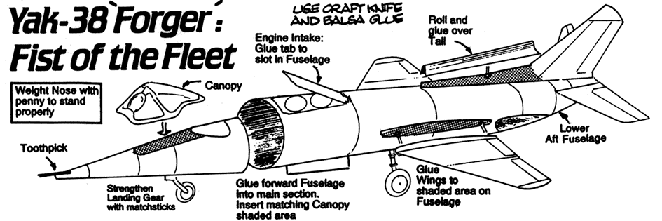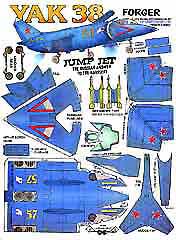
The Russian Yakovlev YAK-38 "Forger" VTOL
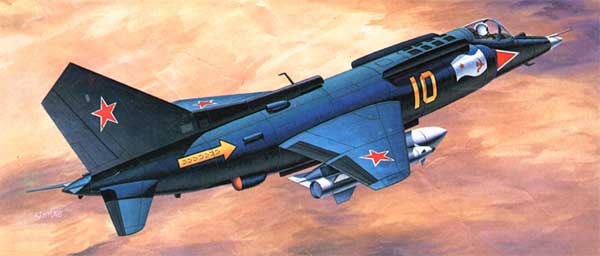
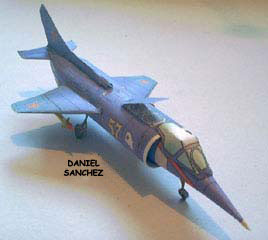
Preceded by the Yak-36 'Freehand' and the barely related yak-36M, the USSR's first operational VTOL aircraft was the Yak-38 'Forger'. Superficially similar to the early Harrier, the 'Forger' was burdened with two extra lift engines, which increased the basic weight and reduced the fuel capacity. Payload was about one-third that of the Mk I Sea Harrier and endurance in hot weather about 15 minutes. A constant problem was ingestion of exhaust gases back into the engine, which caused power loss. Failure of one lift jet (which had an operating life of only about 22hours) would cause an immediate uncontrollable roll. The 'solution' to this was to fit a system that automatically ejected the pilot in the event of an engine failure. Unsurprisingly, as many as one-third of Russia's 'Forgers' were lost in accidents.
Russia's last venture into the V/STOL field was ambitious, involving the supersonic Yak-41, which was given the NATO reporting name Freestyle. The Yak-41 program was initiated in 1975 about the same time that the Yak-38 was first being deployed. The first conventional flight was made on March 9, 1987 and the first hover on December 29, 1989. Two flying prototypes were built and redesignated Yak-141; one of these was lost in a landing accident. The program was abandoned through lack of funds.
The YAK-38 Forger Russian Jump Jet has been included in our range because it's the Soviet's answer to the Harrier...more-or-less. More YAK 38's have crashed making it less of a competitive threat to anyone.
It's so packed with electrical equipment and jet engines that it has almost no payload capacity. The jet engine access hatch hinges open on our model for a realistic effect. Square toothpicks serve as wing tip rockets under wing rockets included with model.
Yak-38 Forger
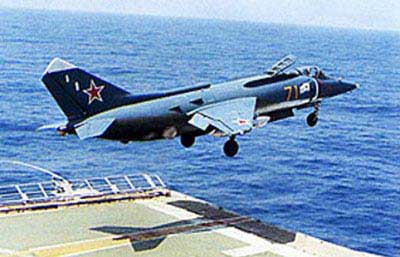
Development of a V/STOL tighter for the Soviet navy's new 'Kiev' class of aircraft-carriers began during the early 1980. Intensive studies bore fruit in the shape of a number of Yak-36 'Freehand' research aircraft. with a bicycle undercarriage under the fuselage augmented by wingtip outriggers. The aircraft is believed to have been powered by a Dair of 8,267 lb Koliesov engines, each with a rotating nozzle. These gave a tremendous thrust margin, and powerful auto stabilizers gave a rock-steady hover, using reaction control 'puffer jets' in the tail, wingtips and at the tip of a long nose-probe. The Yak-36 was not an operational aircraft, although it did lead directly to the Yak-as. This first flew during 1971 (reportedly as the Yak40UP). and was first seen during trials of the Kiev in the Black See during 1975. Required by international treaty to declare details of the vessel's complement, the USSR described the new fighters as 'Vak-38s'. Leading to some confusion among Western analysts until 1984, when East European magazines began to use the type's correct Yak-38 designation.
Powered by a single 15,300-lbf Soyuz/Tumanskiu R2-V-300 turbojet with twin rotating nozzles, the Yak-38 also has a pair of 6,725-lbf Koliesov/Rybinsk RD-36-35FVR lift jets mounted in tandem immediately aft of the cockpit. Initially capable of VTOL operation only, the perfection of an automatic lending system allowed rolling take-offs, with the lift jets being activated and the rear nozzles being rotated automatically at 'the optimum point in the take-off run'. If the aircraft's height, rate of descent or attitude go outside prescribed limits, the pilot is automatically ejected.
The latest estimates suggest that the Yak-38 is marginally supersonic at altitude, and in the ground attack role has a combat radius of about 115 miles. For reconnaissance, a maximum range of about 1286 miles is possible, while in the air defense role a one-hour CAP can be mounted 115 miles out from the ship. Up to four pylons can be fitted under the inboard sections of the wing, able to carry a theoretical maximum weapon load of about 4,409 lb, although two pylons are normally left empty. Yak-38s have been seen carrying US-16-57 and UB-32-57 rocket pods, R60 CM-S 'Aphid') MM's, bombs of up to 1,102 lb, and various cannon pods. Auxiliary fuel tanks can be carried by some modernized and late production aircraft, which bear the designation Yak-SSM.
The Yak-38's unique operating and handling characteristics made the construction of a two-seat trainer essential. The resulting Yak-36U has tandem cockpits under separate sideways-hinging canopies, with the longer nose having a pronounced 'droop'. Improvements during service included the provision of auxiliary blow-in doors in the sides of the main intakes, and fore-and aft fences on each side of the upper fuselage intake for the lift jets. The basic color scheme worn by these aircraft is also changing. The dark green anti-corrosion paint used on the undersides is retained, but the dark blue topsides are giving way to gray upper surfaces. Production of the 'Porger' was limited to about 90 aircraft, and of these 37 are known to have been lost. resulting in 32 ejections (19 automatic), all of which were successful. When deployed, each carrier had a squadron with 12 single-seater's and two twin stickers. Reports that the Yak-38 has bean retired from service or permanently withdrawn from deck operations are almost certainly premature since. although Minsk and Novorossiysk are being mothballed. another of the 'Kiev 'class carriers (Gorshkov, formerly Baku) remains in service and Kiev itself is under repair.
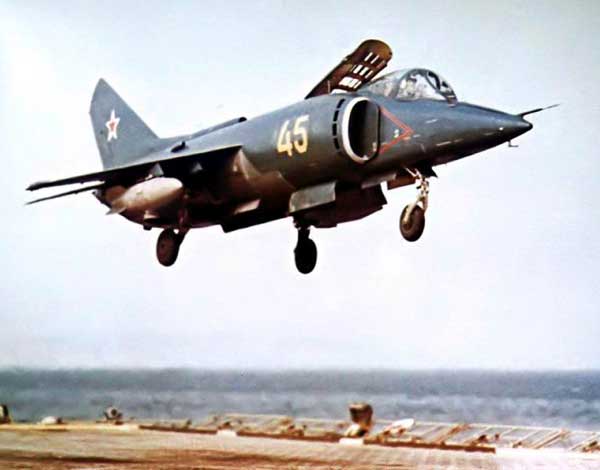
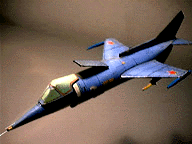 Seconds
later , as you can see, two tiny turbines started to whirr and
then the Yak 38 magically jumped from my hand and attacked the
dog sitting under the kitchen table. Seconds
later , as you can see, two tiny turbines started to whirr and
then the Yak 38 magically jumped from my hand and attacked the
dog sitting under the kitchen table. |
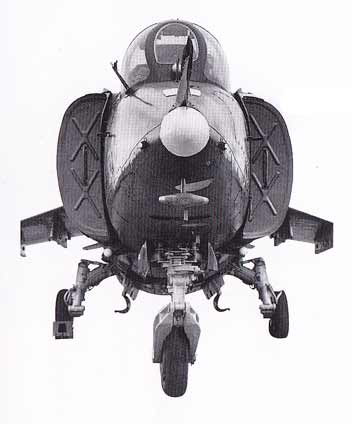 |
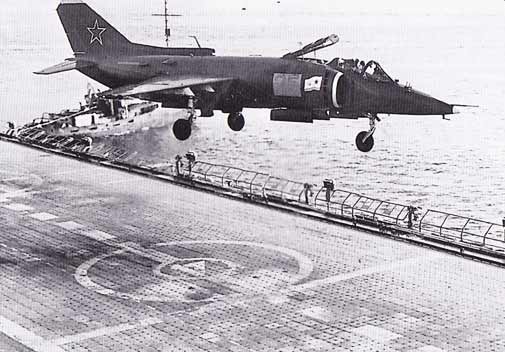 |
Specifications for the Yakovlev Yak-38
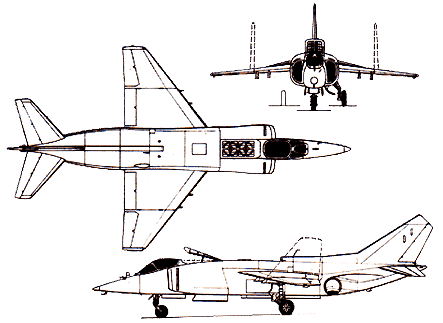 |
Length: 50 ft 1 in Wingspan: 24 ft Height: 14 ft 5 in Wing area: 199 ft² Empty weight: 16,281 lb Max takeoff weight: 28,700 lb Powerplant: 1 x Tumansky R-28 V-300 turbojet, 15,000 lbf Powerplant: 2× Rybinsk RD-38 turbojets, 7,870 lbf each Performance Maximum speed: 795 mph Range: 807 miles Service ceiling: 36,089 ft Rate of climb: 14,760 ft/min Armament Guns: GSh-23L 23mm gun pod (GP-9). This gun could be carried in one or two PUK-23-250 pods fixed under the external pylons of wings. Bombs: 2x FAB-500 or 4x FAB-250 under pylons, two incendiary ZB-500, or 2x nuclear tactical RN-28. Rockets: various types of rockets (up to 240 mm). Missiles: 2x anti-ship or air-to-surface Kh-23. Each missile weighed 628 lbs, was radio controlled and had 6 miles of range. The Kh-23 requires a guidance pod on one of the pylons. R-60 or R-60M air-to-air missiles could be carried under the external pylons. Other: external tanks. |
 |
||
| A: The 'Forger' had a system to automatically eject the pilot if the engine stopped while the thrust was angled below the horizontal. | B: A hinged door opened behind the cockpit to feed air to the lift jets, which exhausted out of a hatch at the bottom. | C: The Yak-38 was very basically equipped, with only a simple weapons sight and no radar or radar warning systems. |
| D: The Yak-38 came as something of a surprise to NATO, first appearing in the Mediterranean in the summer of 1976 aboard the carrier Kiev. | E: Although intended only for vertical take-offs and landings, the 'Forger' had double-slotted flaps and a braking parachute. | F: The Rybinsk RD-38 turbojet lift engines on the Yak-38 were very susceptible to ingestion of exhaust gases back into the engine which would cause them to shut down, or lose power. |



